This article details Toor Dal Farming (Pigeon Peas):
The following article talks about Toor Dal Farming techniques and cultivation practices.
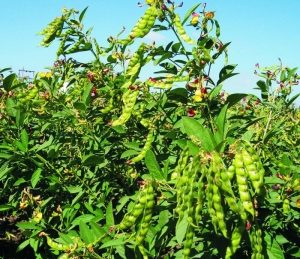
Introduction to Toor Dal/Toor Dhal:
Scientifically known as Cajanus Cajan, Pigeon Pea belongs to the widespread family of pulses. In India Pigeon Pea is more popular than Arhar or red gram. In India, split pigeon peas (Toor dal) are one of the most popular pulses, being an important source of protein in a mostly vegetarian diet. In regions where it grows, fresh young pods are eaten as a vegetable. The split dried seeds are used as a lentil, in dishes such as sambar (lentil soup). Toor Dal is called in other languages as :
- In English: Pigeon Peas, Red Gram, Yellow Lentils.
- In Hindi: Arhar, Tuvar, Toor, tur dal.
- In Tamil: Tovarum Paruppu.
- In Telugu: Kandi Pappu.
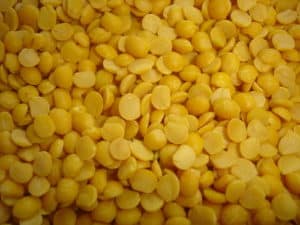
Benefits/Advantages of Toor Dal Cultivation are:
- Survive in poor soil conditions and tolerant of dry weather
- Nutritious and high-protein pulse crop
- Leaves can be used for animal feed or fodder
- The fast-growing plants make good shade for other crops, e. g. vegetables, herbs, vanilla
- Perennial for up to 5 years
- Woody parts can be used for firewood
- Water and nutrients from deep in the soil can be caught by its deep taproot
- Plants can be used along with contour barriers for erosion control
- Helps in agroecology, the performance of Pigeon Pea as an intercrop is remarkable, and even after the harvesting of the intercrops, it continues protecting the soil.
Suitable Climate for Toor Dal Plantation:
Arhar or Toor Dal crop requires average rainfall of 600-650 mm with moist conditions for the first eight weeks and drier conditions during flowering and pod development stage, this will result in a highly successful crop. Rains during the flowering result in poor pollination. Arhar crop grown successfully in summer, rainy and winter season, April-Summer, June-Kharif or rainy, September-Rabi or winter season. A crop of semi-arid tropics tolerant to dry conditions because of a well-developed deep root system. However, the critical growth stages are branching, flowering and pod filling where moisture stress causes adverse effect therefore in the absence of rains high irrigation are required.
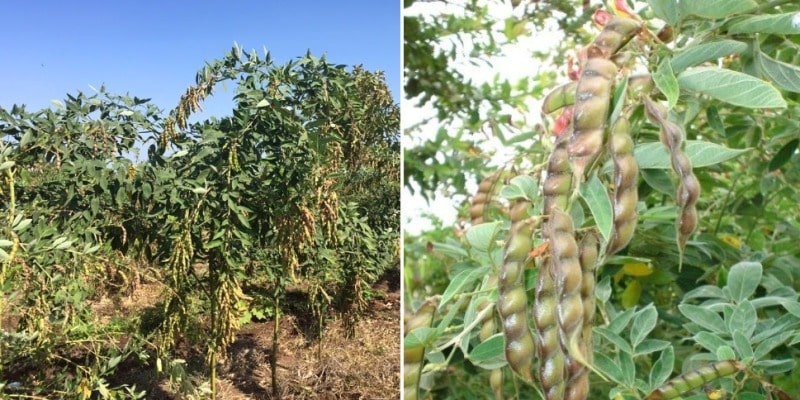
Toor Dal (Arhar) needs moist and warm weather i.e. 30–35°C during germination and slightly lower temperature (20-25°C) during active vegetative growth. During flowering and pod setting it requires 15-18°C temperature and at maturity, it needs a higher temperature of around 35-40°C. Waterlogging, heavy rains, frost are very harmful to the crop. Hailstorms or rain at maturity damages the entire crop. It has a good drought-tolerant capacity because of its deep tap root system.
Soil requirement for Toor Dal Plantation:
This crop grows well on all types of soils but loam to sandy loam soil is suitable. This crop also does well in sloppy lands in the mid-hills. It can be grown successfully on neutral soils having a pH range of 6.5 to 7.5. Make sure there won’t be any water logging in the field.
Read this: Tiger Prawn Cultivation.
Land/Soil Preparation for Toor Dal Plantation:
Red gram or Toor Dal being a deep-rooted crop responds well to a proper tilth. So land is prepared by at least one plowing during the dry season followed by 2 or 3 harrowings and disc plowing.
- Organic manure may be applied 2-4 weeks before sowing.
- Soil should be well leveled so that water stagnation does not take place.
- Contour broad-beds and furrows or a ridge-and-furrow system are useful in preventing waterlogging.
- Weeds should be properly removed, well tilled and crusting should be avoided by mechanical means.
Light irrigation helps in seedling emergence.
Sowing and seed rate in Toor Dal Production:
The seed rate is 15 kg/ha. Tall varieties of Arhar should be sown in rows at a distance of 50 cm while dwarf varieties like HPA-92 should be shown at 30-35 cm row spacing with seed to seed spacing of 15-20 cm. The crop gives a much higher yield if, it is sown in the last week of May. One row of each can also be successfully grown in between two rows of Arhar. In Zone-I, paired row planting of Arhar and sesamum gives a higher return. In the case of paired row planting, two rows of Arhar should be sown at 30 cm spacing followed by two rows of sesamum sown at 20 cm spacing. The seed rate and fertilizer doses to the sesamum crop should be reduced to half of the recommended for pure sesamum crop.
Seed Treatment for Toor Dal Plantation:
- Treat the seeds with Carbendazim or Thiram @ 2 g/kg of seed 24 hours before sowing (or) with powder formulation of Trichoderma Viride @ 4g/kg of seed (or) Pseudomonas fluorescens @ 10 g/kg seed.
- Treated seeds of a suitable variety having high germination and high real value should be selected for sowing the crop.
- Seeds should not be more than two seasons old. Probably it should be produced during the previous season
- Use bolder seeds for better germination and more vigorous seedlings
- Pigeon pea or Toor Dal is a traditionally Kharif crop sown in June-July with the onset of Monsoon in various agro-climatic zones of India.
- Planting of early pigeon pea or Toor Dal before the onset of monsoon in the month of June is recommended for higher yields.
- In irrigated conditions, the crop should be sown by giving one pre-monsoon irrigation at least a fortnight earlier than the first shower so that plants are well established during the rainy season, however, under rainfed conditions the sowing may be done immediately after rains have started. Thus in no case, the sowing should be delayed beyond the last week of June.
The spacing of Toor Dal Plants:
- Long duration varieties of pigeon pea which are tall, spreading, and occupy the field for about 250-270 days are planted at a wider row spacing of 90-120 cm and about 30 cm between the plants, particularly under the rain, fed conditions.
- Early maturing varieties under irrigated conditions are planted at a row spacing of 50-75 cm and plant to plant spacing of 15-20 cm.
- In the case of April planted pigeon pea, a row spacing of 90-120 cm is recommended as the vegetative growth is much higher than June planted pigeon pea.
- If it is Black soil a spacing of 90 x 20 cm is normally recommended. In red soils, 60 x 20 cm spacing usually followed.
Intercropping in Toor Dal Crop:
Intercropping is the growing of two or more crops of dissimilar growth patterns on the same piece of land, with a view to optimizing the total yield and net profits per unit area.
Traditionally red gram is intercropped with cereals, oilseeds, short-duration grain legumes (pulses), or cotton.
Most commonly red gram is intercropped with cereal crops like Sorghum, pearl millet, maize, finger millet, etc.
Red gram – Oilseed intercropping is becoming popular. Groundnut, soybean, and sesame are oilseed crops.
Red gram is also intercropped with short-duration pulse crops such as mung bean, cowpea, black gram, chickpea, etc.
Manuring for Toor Dal Crop:
15 kg of N and 45 kg of P2O5 per hectare is sufficient for this crop.
Weed Control in Toor Dal Production:
Pigeon pea grows very slowly during their early growth period of 45 – 50 days. This makes pigeon pea less competitive with weeds. If weeds are not controlled in time, it can cause up to 90% reductions in seed yield. Therefore it is advisable to keep the field free from weeds.
a weed-free condition may be achieved by giving two hand weedings once about 25-30 days and another about 45-50 days after sowing the crop.
Intercultural Operations of Toor Dal Crop:
Two weedings and hoeings are essential for the crop. Harvesting When nearly 75% of the pods get matured at a time, the crop should be harvested.
Harvesting and Storing of Pigeon pea:
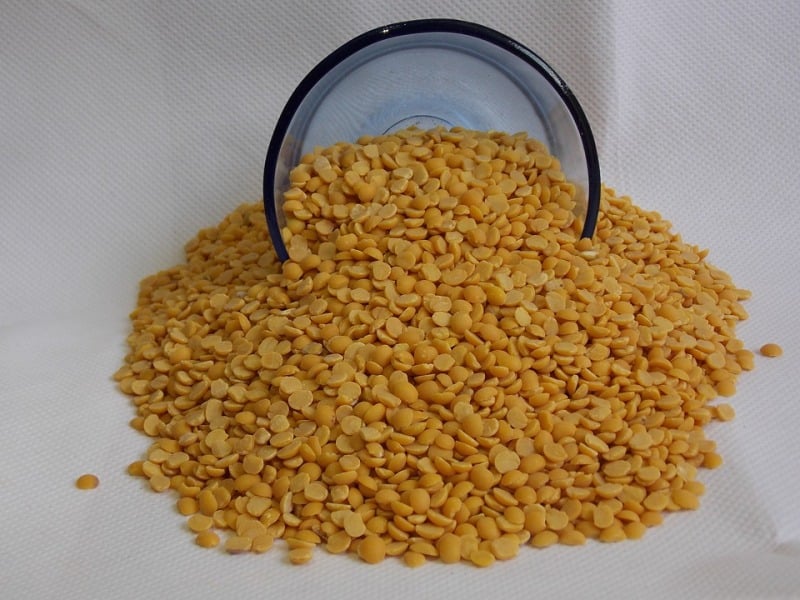
In Toor Dal Farming, Green pigeon pea pods are harvested for different purposes. Fully developed, the bright green seed is preferred for use as a vegetable. Hence, pods should be harvested just before they start losing their green color. For this normally handpicking is followed. Pigeon pea leaves, unlike other crops, remain green when the pods are ready for harvest. This may confuse the decision on optimum harvest time. Pigeon pea should be harvested when 75-80% of the pods turn brown and are dry. Delayed harvesting, during bad weather, may increase the risk of damage to the mature seed.
Traditionally pigeon pea plants are harvested by cutting the stem at the base with a sickle, but occasionally machines are used for cutting and followed by drying and threshing. The harvested plants are bundled and placed upright to dry for a week depending on the weather conditions. Pods and grain are separated by beating the dry plants with sticks or by using a thresher. In some places by cattle trampling seeds are separated.
Pigeon pea is usually stored for long periods to ensure availability of whole seed at the time of sowing, and as a dhal to meet consumer requirements.
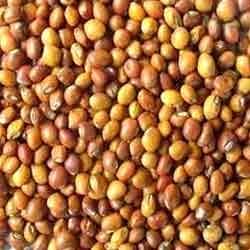
Bottom Line of Toor Dal Cultivation:
Cultivating Toor Dal or Pigeon pea is profitable as it has always a high demand in the market.
That’s all folks about the farming of Toor Dal’s wonderful crop. Keep farming!.
In case if you are interested in this: How To Grow Organic Lettuce.
- Economical Aquaculture: A Guide to Low-Budget Fish Farming
- 15 Common Planting Errors That Can Doom Your Fruit Trees
- How to Make Houseplants Bushy: Effective Tips and Ideas
- Innovative Strategies for Boosting Coconut Pollination and Yield
- Pollination Strategies for Maximum Pumpkin Yield
- The Complete Guide to Chicken Fattening: Strategies for Maximum Growth
- Natural Solutions for Tulip Problems: 100% Effective Remedies for Leaf and Bulb-Related Issues
- Revolutionizing Citrus Preservation: Towards a Healthier, Greener Future
- Natural Solutions for Peony Leaf and Flower Problems: 100% Effective Remedies
- Maximizing Profits with Avocado Contract Farming in India: A Comprehensive Guide
- Natural Solutions for Hydrangea Problems: 100% Effective Remedies for Leaf and Flowers
- The Ultimate Guide to Choosing the Perfect Foliage Friend: Bringing Life Indoors
- From Sunlight to Sustainability: 15 Ways to Use Solar Technology in Agriculture
- The Ultimate Guide to Dong Tao Chicken: Exploring from History to Raising
- The Eco-Friendly Makeover: How to Convert Your Unused Swimming Pool into a Fish Pond
- Mastering the Art of Delaware Chicken Farming: Essentials for Healthy Backyard Flocks
- 20 Best Homemade Fertilizers for Money Plant: DIY Recipes and Application Methods
- How to Craft a Comprehensive Free-Range Chicken Farming Business Plan
- Brighten Your Flock: Raising Easter Egger Chickens for Beauty and Bounty
- How to Optimize Your Poultry Egg Farm Business Plan with These Strategies
- Subsidy for Spirulina Cultivation: How Indian Government Schemes Encouraging Spirulina Farmers
- Ultimate Guide to Raising Dominique Chickens: Breeding, Feeding, Egg-Production, and Care
- Mastering the Art of Raising Jersey Giant Chickens: Care, Feeding, and More
- Ultimate Guide to Raising Legbar Chickens: Breeding, Farming Practices, Diet, Egg-Production
- How to Raise Welsummer Chickens: A Comprehensive Guide for Beginners
- How to Protect Indoor Plants in Winter: A Comprehensive Guide
- Ultimate Guide to Grow Bag Gardening: Tips, Tricks, and Planting Ideas for Urban Gardeners
Good day, Interested in the commercial farming of pigeon peas in South Africa. Require your assistance.
Please go through the article, you can understand of basic methods of pigeon pea farming.
I’m agriculture graduate
And experience in production of oil seeds pulses
How to separate brown peel from harvested toor dal to get yellow coloured fresh pulses like we get in market.
There is a post harvesting process of Toor dal to get the refined yellow pulses. We will update soon about Post harvest process for TOOR DAL.
Very good guide
Which state is it growing well?
Tamil Nadu, Andhra pradesh, Karnataka, Maharashtra and Telangana.
Pigeon is said to be a perennial crop with a 5 year life span. Does it mean same plant can be harvested for five years once it is planted.pl share some information about it.
Dear Sir, where is the best variety of Toor Dal grown in our country. I am looking at buying the best variety of toor dal directly from the farmer and hence would like to know the source. I prefer the processed toor dal which is ready to be used in kitchen. To be more specific I am looking at the quality which is similar or better than Shivling Toor Dal variety. Your advise here will be of great help and support, thank you
How to make toor to toordall finished good
I have the same question as Mr. Vikram, You have mentioned harvesting but we would like to know if there is any home based technique to process Toor dal [ remove the skin and split it] . Ours is a small scale framing not high yield to take it to the mill for processing. We would like to process it at farm , if there is any such technique or video it would help or if there is a process please share will appreciate it.
Thank you
Dear Mr. Jagdish Thank you for information on growing Tur dal, whereas i was looking forward for variety of Tur seeds which you have missed to mention. This Kharif i am planting white Tur seeds which brings about what we call as Shivaling tur dal.